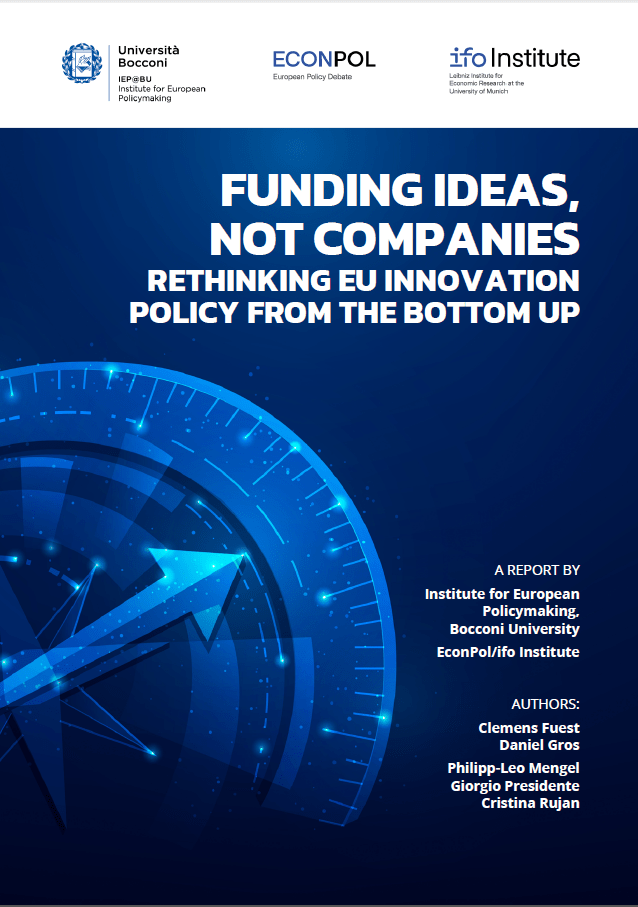Funding Ideas, not Companies - Rethinking EU Innovation from the Bottom Up
Competitiveness has returned to the top of the EU agenda, with the EU Competitiveness Compass highlighting the need for innovation-driven growth. But European industry has fallen behind in innovation by specializing in mid-tech industries, now increasingly subject to Chinese competition.
Since the start of Horizon 2020, the EU budget has provided about €100 billion to support research and innovation. But this seems to have had little impact.
A large proportion of Horizon funding has gone to a small number of big corporations with modest innovation and growth performance. Another sizable share goes to SMEs that are part of wider corporate groups.
Moreover, the lion’s share of Horizon funding has gone to collaborative programs, with detailed guidelines on research topics and expected outcomes, typically involving broad-based consortia with more than 20 participants. Yet our analysis suggests that bottom-up programs undertaken by individual recipients yield better results, but only if the recipients are independent SMEs.
Any new Framework Program should thus focus on funding ideas, not companies. They key is not more money, but rather leaving space for disruptive innovation by encouraging bottom-up initiatives, especially by small independent companies.

Executive Summary
This report examines the track record of EU support for R&D over the past ten years. The backdrop is an EU industrial landscape largely anchored in mid-tech sectors. Notably, the five largest R&D spenders in the EU are all in the automotive industry. Over the past two decades, the share of EU firms in high-tech sectors has dropped by half—from 22% to just 11%.
Given this context, the success of the Horizon program should be evaluated based on whether it has effectively fostered the innovation-driven growth envisioned in the EU’s Competitiveness Compass.
-
FileIEP_ifo_report_ideasNotCompanies (3.86 MB)
-
FileIEP-COMPET Dataset.pdf (909.54 KB)
- Funding allocation skewed toward low-growth firms
More than half of Horizon program funding goes to mid-tech firms and consultancies with limited innovation and growth potential.
- Dominance of large corporate groups
Many beneficiaries are repeat recipients—some involved in up to 200 projects—typically belonging to wide corporate groups. These entities receive funding for research close to their corporate interests.
- Collaborative instruments: Limited impact
Most Horizon funding (60-80%) is directed to collaborative instruments involving sizable international consortia with detailed top-down research agendas. However, there is no evidence that these collaborations improve recipients’ long-term growth or innovation outcomes. Some positive effects are observed during the grant period (about three years), but they do not persist beyond the funding horizon.
- Collaborative instruments: Research programs dominated by Member States
The work programs for these collaborative instruments are elaborated by big program committees in which national, often corporate interests dominate. This leads to programs that seek incremental, rather than radical innovation.
- Early-stage innovation support seems ineffective
Grants targeting early-stage innovation often go to large corporate entities rather than small independent firms. For these large firms it is difficult to measure the impact of relatively small grants.
- Single-entity, SME-targeted instruments show the most promise
Funding programs like the SME Instrument and European Innovation Council (EIC) Accelerator show significant and lasting positive effects—but only for small, independent firms (i.e. SMEs that do not belong to wider groups). These companies are also more likely to file high-tech patents.
- Limited reach of effective funding
Only 35% of funding reaches independent innovators in the sample; the figure drops to 12% for the overall Horizon program. Additionally, the strongest growth effects are observed in consultancy and support service sectors, not in IT or manufacturing.
- Refocus Horizon funding
Reallocate resources from collaborative instruments to SME-targeted programs—especially those supporting early-stage, high-potential innovation—within Pillar 3 of Horizon Europe (under the EIC).
- Support independent innovators
Prioritize funding for small, independent companies that do not belong to corporate groups. Impose limits on repeated participation and restrict funding to consultancy firms.
- Encourage novelty and bottom-up innovation
Promote open and flexible calls to allow space for novel and diverse ideas, following the EIC’s “Challenge” approach.




